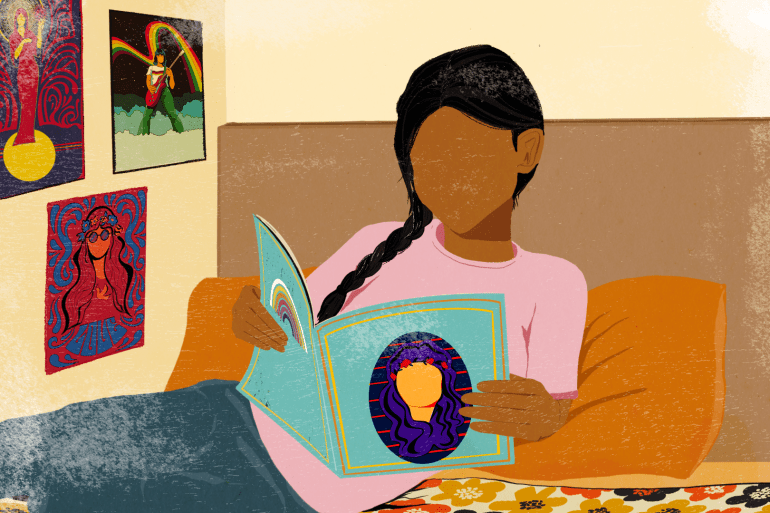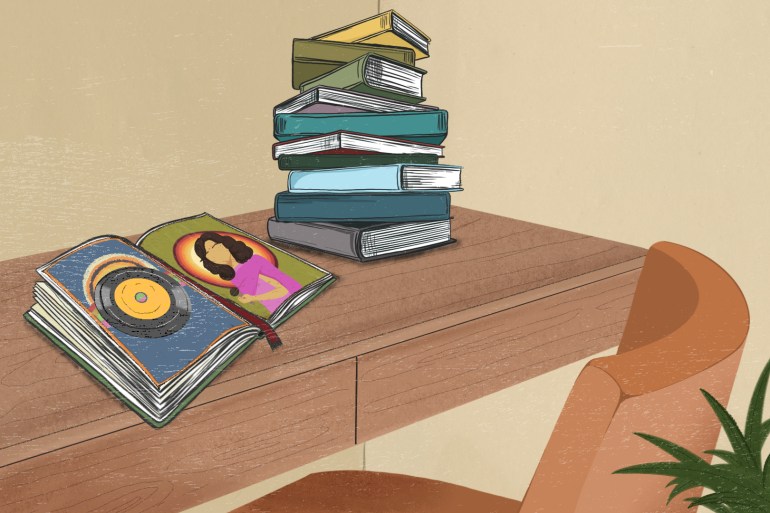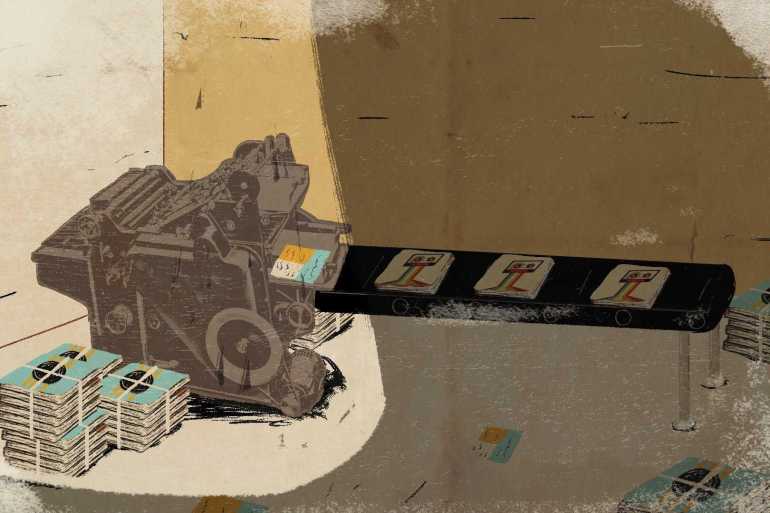The rise and fall of JS, India’s 70s cult youth magazine
It was the voice of the progressive youth, then it disappeared. In 2016, a lucky discovery helped preserve rare issues.

Kolkata, India – One afternoon in the summer of 2016, a 24-year-old college graduate returned from lunch to find a surprising sight in his Mumbai office.
Piled on his desk were thousands of pages of JS, an iconic Indian youth magazine that ran from 1967 to 1977 and had all but vanished after the publication closed.
Keep reading
list of 4 itemsThousands protest against Israel’s participation in Eurovision final
Boos for Israel’s entry at Eurovision rehearsal
Dystopia of Seoul: AI re-composes Vivaldi concerto using climate data
J, who wishes to remain anonymous, had been trying to track down old issues. But they were not just hard to come by – they simply did not seem to exist. So he was stunned by the sight.
The then aspiring singer-songwriter had discovered the magazine the previous year while reading a book about rock music in India.
In India Psychedelic: The Story of Rocking Generation, author Sidharth Bhatia described JS as being for India’s “hipster urban youth”.
“The air of frivolity was all-pervasive,” Bhatia wrote of the magazine. “It seemed as if not just the readers but also the writers were out to have fun.”
J was intrigued. In Kolkata, the capital of West Bengal state, where he lived at the time, and where the magazine was once based, he asked musician friends if they knew where he could find old copies. No one did. Many hadn’t heard of it, but those who were teenagers or young adults in the 1970s remembered the magazine fondly and lamented its closure.

A coincidence
JS was a weekly – later fortnightly – magazine published by the then-popular Kolkata-based English language daily newspaper, The Statesman.
Although J had grown up in Kolkata, he had never come across JS before.
A Google search turned up some written accounts by former staff, but nothing extensive, not even a Wikipedia entry.
Then, a year after starting his search, by coincidence, J joined The Statesman’s marketing team in Mumbai. Circulation-wise, the paper had no presence in the city, but all the advertising decisions were made there.
His workplace was the former Mumbai office of JS, so J asked the office clerk if there were any old copies lying around. At lunchtime, the clerk climbed a ladder and searched the topmost storage cupboards. He pulled out about eleven hardbound books, each with dozens of issues bound together, and left them on J’s desk.
When he returned from lunch to find them there, J immediately started flipping through them. He was, he says, “enamoured”.
There was an essay about a man hitchhiking through Europe with a friend in 1972; ads for Radio Ceylon, a Sri Lankan radio channel that played Western pop and rock music as well as Hindi film music and had become popular in the 1950s at a time when India’s national broadcaster, All India Radio, had banned everything apart from Indian classical music; and a profile of Junko Tabei, the first woman to reach Mount Everest’s summit.
“Just browsing through the pages – a cursory glance – took me a week, because of the volume and I hadn’t even started reading anything yet,” he says.

Sneaking out the magazines
J knew he couldn’t skim through all 5,000 pages at work. But, realising how lucky he was to get his hands on them, he decided to sneak the issues out to make scanned copies.
“I wanted to make sure that it gets preserved and doesn’t get lost, because it was literally lying there, ignored,” J says.
Most photocopiers asked for 20 rupees ($.27) per page. But that would total about 100,000 rupees ($1,333), which J couldn’t afford.
Finally, after telling one that the magazine ran the risk of disappearing if he didn’t get the pages scanned, the man agreed to charge 1 rupee ($.01) per page and to keep the shop open an extra hour every evening.
J’s colleagues had already begun to get suspicious – one had warned him not to discuss JS outside the office because it had shut down for “controversial reasons” and told him to stop asking questions – so he couldn’t smuggle all the magazines out at once.
Instead, he snuck out one or two hardbound books at a time, taking them to the photocopier before returning them to the office.
It took him eight days, but eventually, there was a solid archive of issues from between 1970 and 1977.
The magazines were full of interviews with popular musicians and actors, reviews of the latest Indian and Western albums, posters of celebrities, and fashion advice (“Tear A Maxi Into Mini In Seconds”). Still, many pages and entire issues were missing, like the one featuring an interview with Led Zeppelin’s Jimmy Page and Robert Plant, and there was no trace of the very first issue from February 1967, which had The Beatles on the cover.

An Indian youth publication
“As an old soul, even today, I connect with the time and culture that JS was the result of. I guess that’s the reason I was so inclined towards its content,” J explains.
He saw it not only as a window into the youth culture of that era but as having helped to shape it.
“In addition to being the precursor to modern Indian advertising and journalism, JS was a catalyst to the inevitable emergence [in the 1970s] of the progressive Indian youth it had been endorsing,” he says.
JS was the brainchild of Alfred Evan Charlton, the last British editor of The Statesman, which was founded under British rule in 1875. Charlton, who was critical of the British leadership, was respected by Indian readers.
After India’s independence in 1947, he was among a minority of British who stayed behind. Just as the colonial social clubs in Kolkata established by the English gradually passed to Indian leadership, so too did newspapers.
Charlton, who was replaced by The Statesman’s first Indian editor Pran Chopra, had wanted to create something for adolescent readers so that brand loyalty towards The Statesman could be inculcated from a young age. Before leaving for England in late 1966, Charlton hired Desmond Doig, an Anglo-Irish soldier who had fought with the Gurkhas in Italy during World War II and an assistant editor with the newspaper, for the top job.
Charlton had conceived of JS as a children’s magazine. But, as editor-in-chief, Doig changed its course.
While the West had magazines like MAD, Melody Maker and Punch, there weren’t any publications in India at the time that specifically targeted young people.

JS comes of age in 1960s Kolkata
1960s Kolkata was a politically turbulent city. There were the beginnings of the Naxalite movement, an ongoing insurgency between the radical left and the Indian government, and labour strikes and protests by student unions had become common. Kolkata was dirty, chaotic, violent, and dark because of frequent power cuts.
It was also known to be a city of mostly middle-class intellectuals.
Lifestyle, fashion, and music influences from the West had started spreading in India and Kolkata was becoming a go-to city for contemporary musicians who wanted to make it big.
Doig had been quick to notice these changes and, with no other publication tapping into them, imagined JS filling this niche.
A first-rate journalist who had joined The Statesman as an artist doing weekly sketches, Doig had gone on to expose the state of government hospitals, was the first person to write about the Albanian nun Mother Teresa who went on to win a Nobel Peace Prize, and as a mountaineer and “official reporter” accompanied Sir Edmund Hillary on his Mount Everest expedition.
Doig recruited Dubby Bhagat and Bhagat’s college friend Jug Suraiya to write. A sub-editor at The Statesman’s Delhi office, Sadhan “Charlie” Bannerjee, was also hired, as was Papa Menon as a trainee sub-editor.
This initial editorial team of five grew into a core team of about 20 people, including Deb Mahalanobis who led design and CY Gopinath, a roving reporter. The magazine targeted readers between the ages of 15 and 25. A few years after launching, it changed its name from Junior Statesman to JS because the word “junior”, gave the impression that it was a children’s magazine. The typical JS reader was an urban, English-speaking young person from an upper-middle or upper-class family.
While most of the JS staff was male, there were upwards of 15 women who contributed regularly. The sister duo Papiya and Tuk Tuk Ghosh often wrote for ‘Kookie Kol’, a witty Q&A column.

Thinking young
JS was a handbook on what to wear, what to talk about, what to do, and what to listen to. With every issue, it became clear that JS, as Bhatia puts it in his book, “had its finger on the pulse of the youth”.
It was fresh, intelligent, funny, and bold.
One of its most popular columns was Disc-Cussion, authored by Bhagat.
Bhagat, who introduced Indian youngsters to the music of Led Zeppelin and Jimi Hendrix, would make frequent trips to England to buy the latest rock and jazz records, says Lew Hilt, a musician who lived in a shared house with Bhagat for a time and was regularly featured in the magazine.
He described how Bhagat would return to Kolkata with a suitcase stuffed with LPs and how they would listen to the records “from the time we woke up to the moment we slept”.
Although music was its main focus, the magazine also featured crosswords, comic strips and short stories. There were weekly horoscopes, sports news and a popular column called ‘Rear Window’ written by Suraiya. These were thought pieces “with discussions on Sartre, Nietzsche and others, but told in Jug’s inimitable way,” writes Bhagat, referring to Suraiya’s use of big words, in his 1999 essay ‘The World’s Oldest Teenagers’ about his time with JS.
Once, when Suraiya was stuck for ideas, he decided to write about the Emergency that Indira Gandhi, India’s then prime minister, had declared in 1975. Civil liberties were suspended, the press was censored, elections were cancelled, a mass forced sterilisation operation was carried out, and several human rights violations had taken place. During the Emergency, one wasn’t allowed to use the word ‘emergency’, so Suraiya replaced it with ‘exigency’ and evaded the censors.
Ad agencies were asked by clients to design magazine ads with the JS reader in mind and some advertisers even asked JS to design ads for them.
The covers featured musicians and celebrities and in the earlier designs, the letters ‘JS’ came with the tagline: “The magazine that thinks young”.
Centre spreads contained posters – photographs or artwork – of world-famous rock stars, local musicians and Hollywood or Bollywood celebrities that readers could tear out and stick to their walls.
Connecting movements
The design of the magazine from its psychedelic covers to its layout and typefaces attempted to connect with global and Western cultural movements and a “new sense of freedom”, according to Dr Vaibhav Singh, a postdoctoral researcher of typography at the University of Reading in the UK.
JS put a localised spin on the “hip and modern”.
“JS spoke to a certain urban educated cultural sensibility that was, in a sense, Westernised, but it was shaping a distinctly Indian cosmopolitanism,” says writer and politician Shashi Tharoor who at 11 became its youngest-ever contributor.
“The late 60s urban Indian society was made up of children and adults. There was nothing in between. We, at JS, invented the Indian teenager,” wrote Bhagat in his 1999 essay.
In the decade that JS was in publication, several global and cross-cultural movements made an impression on urban Indian youth but unlike in the West, these were not always about rebelling against an establishment but about embracing cultural influences.
Miniskirts, crop tops, polka dots, bell-bottoms, bouffant hair, and oversized sunglasses became fashion trends in India.
In 1968, The Beatles came to India to study transcendental meditation under the guidance of Maharishi Mahesh Yogi. As an English rock band that was using Indian instruments, they became an immediate hit in India.
A few years later, the song ‘Dum Maro Dum’ from the 1971 Bollywood film ‘Hare Rama Hare Krishna’ became an Indian hit. The video features longhaired hippies smoking marijuana, and actress Zeenat Aman wearing a marigold garland and singing about smoking “weed so all your worries disappear”.
In the same year, the “Sneha Yatra” festival took place in the Western Ghats of India. Dubbed the “Indian Woodstock”, some 5,000 people attended.
Indian bands inspired by Western musicians as well as Indian classical musicians performed at the festival. Musicians in India, Bhatia notes in his book, didn’t have the kind of instruments their Western counterparts were using, so they used cheaply-made local versions of Gibsons and improvised with Ahuja amplifiers that were used at political rallies and weddings.
Many publications criticised Sneha Yatra as something disrespectful towards Indian culture, but, according to Bhatia, JS dubbed it “The Happening”.

Trincas: the jazz and rock hotspot
In the 1960s, bands and performers from all over the country wanted to play in Kolkata venues like Blue Fox, Trincas, and Mocambo.
The pop, jazz, and playback singer Usha Uthup was 22 when in 1969 she started singing live at the bar and restaurant Trincas.
JS writers often hung out there after work and watched her perform.
“In those days that was the magazine,” says Uthup who was featured several times on its cover.
After a makeover in the 1950s, Trincas, which had started as a tearoom and bakery in the 1930s, became India’s rock-and-roll and jazz hotspot.
Situated in a colonial building, it was defined by a relaxed vibe, dim lights, and heady music.
“When rock ‘n’ roll was the anthem of the young and rebellious and somewhat frowned upon by ‘respectable types’, Trincas chose to champion [it],” says Sunny Puri, whose father Om Prakash owned the venue during its heyday. So the young and hip flocked there, he explains.
“This was exactly the readership that the Junior Statesman had. The JS was avant-garde and so was Trincas,” says Puri.
Office life
In Kolkata, the JS team occupied a mezzanine floor of Statesman House, an old colonial building situated in Chowringhee Square, one of the early neighbourhoods developed by the British during the colonial period.
Suraiya, who wrote for the magazine for as long as it ran, describes it as being very democratic and without hierarchy, except for the fact that Doig was the boss.
“There were never any temper tantrums or rubbing up on egos. Every day, one would look forward to it; one never felt oh gosh I have to go and work,” says Nondon Bagchi, a musician who regularly featured in JS and later became a sub-editor and writer for the magazine. He even remembers playing cricket inside the office corridors.
“There was a youthfulness about the place, it wasn’t stiff and forbidding,” says Gopinath.
Unlike staff at The Statesman, JS employees didn’t have to tuck their shirts in or dress formally, and most sported long hair, bell-bottoms, and denim.
Although JS employees earned less than their counterparts at The Statesmen, there was a rumour that employees of The Statesman were disgruntled because JS staff had been given brand new, shiny, steel desks, while they had to make do with their old wooden desks, says Suraiya in his memoir, ‘JS and the Times of my Life’.
Those peripherally associated with the magazine such as musicians and freelance writers and photographers often visited the office and became part of what Bhagat referred to as the “JS family”.
Those who worked with Doig, who in the late 1960s was in his late forties, remember him as a larger-than-life character – a vibrant, joyful, and dynamic leader.
He would host parties in his company-assigned flat with Buddhist thangka paintings, a wrought-iron spiral staircase leading to nowhere and a red telephone booth that had been made by a local carpenter to resemble those in London.
Everyone linked to JS was welcome.
Tharoor, whose adventure novel Operation Bellows was published over six JS issues, the first in March 1967 – a week before his 11th birthday – remembers being invited to one of Doig’s parties and being intimidated by the cool, cocktail-drinking adults. (Tharoor’s father ran the Mumbai office of The Statesman and had sent his son’s work to Doig who decided to publish it.)
Tharoor cherishes the earnest conversations he had with Bhagat, Suraiya, and Doig who, he says, did him the great honour of taking him seriously.
JS was a “happy, popping place with freaky looking people and all kinds of stories from people about the fun that everyone was having,” says Gopinath. But this also meant it was envied by its parent – or older sibling – The Statesman.
The main paper was a “staid and stuffy place with a colonial temperament and they always looked at us with a certain amount of cynicism,” he says.

The end of days
These differences eventually came to a head. In 1968, Cushrow Russi Irani, a former insurance lawyer in his late 30s, was appointed managing director of The Statesman. He was a relative of NA Palkhivala, the chairman of the consortium of businesses that owned The Statesman.
He had a military way about him and, according to Suraiya, walked in quick short steps as if heading into a battle.
While The Statesman, which had been in existence for about 100 years, enjoyed far higher circulation figures (160,000 compared to 40,000 for JS, according to Suraiya’s estimates) the magazine had managed, in just one decade, to outshine its parent paper in terms of sheer fandom.
“People read The Statesman then chucked it away – the shelf life was one hour,” Suraiya says. “JS readers read the magazine over a fortnight; everything in that magazine was read. It’s like the difference between a fast food joint and having a gourmet meal.”
“It offended Irani that Doig was more successful and famous than him, and the JS, which had very little money or anything going for it, was much, much more important than his paper,” says Pritish Nandy, a writer, politician and filmmaker whose poetry was published in JS.
Editorially, Doig didn’t answer to Irani but because JS was a unit of The Statesman it deferred to the main paper. Suraiya says that Irani and Doig initially got along, but Irani started to resent Doig’s prominent persona and tightened JS’ budget. In 1977, he shut it down altogether.
“Irani didn’t even tell Desmond he was going to do it,” says Suraiya. “He just ordered the printing press to stop printing.”
The ground floor printers were instructed to stop halfway through printing an issue. Doig, who was informed by a staff member, immediately picked up the intercom to speak to Irani. But nobody seemed to know where he was.
Disbelief among the JS staff soon led to the feeling that it had been inevitable. Suraiya wonders how JS, a publication so different from The Statesman, had been allowed to run for a decade.
Suraiya, Tharoor, Gopinath, and Uthup, said the closure felt personal, like the death of a family member.
Its employees were offered a job with the parent paper, but Gopinath was so angry that he says he sent a “stinker” of a resignation letter to Irani and didn’t even serve his notice.
Doig left India for Nepal along with Bhagat and another colleague. In an interview several years later, Doig suggested it had been time to move on. “After 10 years it [JS] felt old,” he said. But some who worked with him said the magazine’s closure upset him so much that he wanted to make a fresh start in another country. Doig passed away in 1983, Bhagat in 2016.
After JS wound up, Gopinath says The Statesman bound up the magazines and made books out of them for the purpose of record-keeping. Each book contained about 20 to 30 issues.
Ralph Pais, the bassist of The Savages who had been regularly featured in JS, joined The Statesman’s Mumbai office in 1989 as general manager and worked there until 2005. While he was there, the archives kept by the Kolkata office sat in a warehouse rotting. But there were some in the Mumbai office that Pais says he showed to whoever asked to see them, including Bhatia.

The JS archives
In 2019, a master’s student at a reputed university in Kolkata started work on a thesis about the city’s rock music culture.
He approached The Statesman office in Kolkata to access the JS archives but says he was told that he would need to pay 1,500 rupees ($20) to scan one page.
Even a letter from the university didn’t help his case. So he informed his supervisor who then connected him to another professor at the university.
The professor, who asked not to be named, told the student that the department unofficially had digital archives of JS, which had been donated by J.
J had gotten in touch with the professor and offered to share all the scanned issues he had so that they could be used by students and scholars.
“Since J hadn’t obtained these pages through official channels, and we are in receipt of stolen goods, I’m afraid that The Statesman might come after us and ask us to give everything back to them, and we will have to,” the professor explains.
Many of the writers who worked for it and musicians who were featured in it say it is a shame the iconic magazine was never systematically archived.
There have been no efforts by The Statesman to digitally preserve the magazine in later years even as the technologies to do so have become more common.
Suraiya suspects this was in part because Irani didn’t want to be reminded of it. As well as being The Statesman’s managing director, from 1991 to 2003, Irani was also its editor-in-chief. He died in 2005.
Questions sent to the current editor of The Statesman, Ravindra Kumar, about the lack of digitisation and any future plans to create a digital archive went unanswered.
Tharoor believes that if The Statesman digitised back issues it would find an audience. “They would easily recover their costs from grateful nostalgics like myself,” he says.
But Suraiya doesn’t have much hope. Even though The Statesman has a small but loyal readership today, he says it is struggling to survive.
For J, those thousands of pages are an important time capsule of a progressive youth culture.
Digital copies are as “imperishable” as something can be in today’s world, says J, who also archives old and rare music as a hobby.
“It’s unfortunate that such a seminal publication became a victim of its own success and never received its due posthumous recognition,” he reflects.